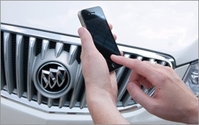automotive
Automakers Ramping Up Geo-Located Ads
- by Karl Greenberg , May 13, 2014

If any retail category should go heavy on geo-fenced mobile ads it is the auto category. Dealerships tend to be clustered in the same geographical suburban areas, so they are like fishermen dropping baited hooks in the same corner of the pond. If hungry fish are likely to go there.
Not too many dealers, or dealer groups are doing geo-located advertising programs yet, but mobile ad firm Verve says all of that is changing. The firm, whose platform channels ads on local content mobile sites, reports in its new “State of the Market: Location Powered Mobile Advertising, Deep Dive on Auto” report that adoption of mobile geo-fencing advertising is increasing across all auto marketing tiers and objectives.
The firm says that its research, based on traffic through its system and on 125 auto campaigns last year and this year, suggests auto retailers are quickly increasing their commitment to geo-fencing. The firm says 17% of auto category spend across national, regional and individual dealer (Tier 1, 2 and 3, respectively) is on location-powered ads. That puts it number two in front of restaurants (12%) and second only to retail, at 28%. The firm, whose data is based on media impressions on its own platform, finds that Tier 2 regional dealer groups run 76% of the location-based auto campaigns, while Tier 1 constitutes 22%. Tier 3, or individual dealers are only 2% of geo-based ads on the platform.
advertisement
advertisement
James Smith, chief revenue officer at New York-based Verve, tells Marketing Daily that the company noted strong engagement with ads regardless of whether the shopper is at the advertiser’s dealership, or someone else’s. "Say you are on a Toyota lot and see a Honda ad; we found consumers [in that situation] spent just as much time on the Honda ad interacting on features as if they had received the ad when not on the dealer's lot,” he says. “The second thing we saw is that those geo-conquest ads [from dealer A when a shopper is on dealer B's lot] resulted in even higher conversion than those who received ads via simple geo-fencing [ads delivered to people in a general area within the vicinity of the dealership]," he says.
But in both cases the ads are apparently effective. The firm's foot traffic insights analysis showed that Tier 2 campaigns with simple geo-fencing as a tactic saw a 295% lift in foot traffic versus people who got non-location-based ads. Those with geo-conquesting as a tactic showed a 377% lift. "You drive volume with geo-fencing, but impression-by-impression, geo-conquesting is more effective. After all, you are talking to the bottom of the funnel. That's where the 'magic beans' are," says Smith.
On Verve's network shoppers spent about 21 seconds on geo-fenced ads when the ads were served while the shopper was in that brand's showroom. Pretty much the same held true when they were on the lot of a competitive brand.
Smith says the tactic also has value for Tier 1 in terms of targeting. "You can follow audience behavioral patterns in the physical world.” He said that such data, combined with demographic information, allows marketers to build customized, verifiable demographic models for ad delivery. The firm found that Tier 1 rich media mobile ads aligned with national campaigns and highlighting the model's features garnered 20-second engagement times.


